Tourism in the Philippines
Tourism is an important sector for Philippine economy. In 2015, the travel and tourism industry contributed 10.6% to the country's GDP.[3] Philippines is an archipelagic country composed of 7,641 islands with 82 provinces divided in 17 regions. The country is known for having its rich biodiversity as its main tourist attraction.[4] Its beaches, heritage towns and monuments, mountains, rainforests, islands and diving spots are among the country's most popular tourist destinations. The country's rich historical and cultural heritage, including its festivals and indigenous traditions, are also one of the attractions of Philippines. Popular destinations among tourists are Cebu, Boracay, Palawan, Siargao, and many more.
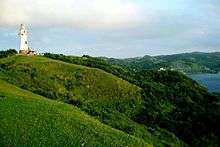

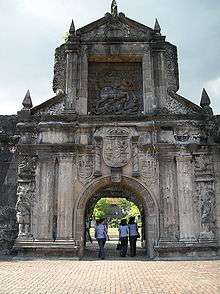

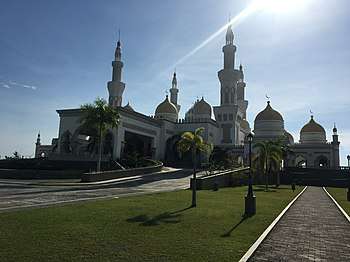



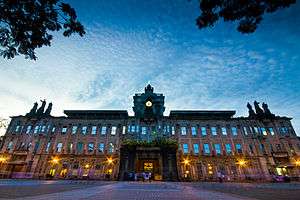
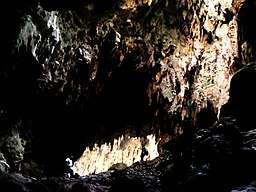
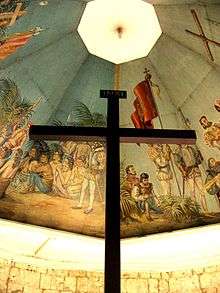

As of 2015, 4.99 million Filipinos have been employed in the tourism sector and the government collected P227.62 billion pesos from foreign tourists, almost 25% of which came from Boracay. The country attracted a total of 5,360,682 foreign visitors in 2015 through its successful tourism campaign of "It's More Fun in the Philippines". In 2017, foreign arrivals peaked at 6,620,908.[5]
Philippines has garnered numerous titles related to tourism, namely, the traditional capital of the world's festivities, the capital of the western Pacific, the centre of Hispanic Asia, the Pearl of the Orient Seas, center of the Coral Triangle, and the capital of fun. The country is also a biodiversity hotspot, having the world's highest endemism rate for bird species, and one of the highest for mammals and flora. It is also the largest bastion for Roman Catholicism in all of Asia. The country is also home to one of the New7Wonders of Nature, the Puerto Princesa Subterranean River National Park, and one of the New7Wonders Cities, the Heritage City of Vigan. It is also home to six UNESCO world heritage sites scattered in nine different locations, three UNESCO biosphere reserves, three UNESCO intangible cultural heritage, four UNESCO memory of the world documentary heritage, one UNESCO creative city, two UNESCO world heritage cities, seven Ramsar wetland sites, and eight ASEAN Heritage Parks. More than 90% of Filipinos can understand and speak English, as many are multilingual.[5]
Overview
Tourism makes an important part to the economy of the country. The growth of the economy had been into a major change since the end of the People Power Revolution up until the present time because of the growth of tourism.
In 2000, Philippines' tourist arrivals totaled 2.2 million. In 2003, it totaled 2,838,000, a growth of almost 29%, and was expected to grow as much as 3.4 million in 2007. In the first quarter of 2007, the tourist arrival in Philippines grew as much as 20% in same period last year. In 2011, the Department of Tourism recorded 3.9 million tourists visiting the country,[6] 11.2 percent higher than the 3.5 million registered in 2010.
In 2012, Philippines recorded 4.27 million tourist arrivals, after the Department of Tourism launched a widely publicized tourism marketing campaign entitled "It's More Fun In the Philippines".[7]
The 2017 Travel and Tourism Competitiveness Report of the World Economic Forum ranked the Philippines 79th out of 136 countries overall. The country's best-rated features were price competitiveness (22nd) and natural resources (37th).[8]
The tourism industry employed 3.8 million Filipinos, or 10.2 per cent of national employment in 2011, according to data gathered by the National Statistical Coordination Board. In a greater thrust by the Aquino administration to pump billion to employ 7.4 million people by 2016, or about 18.8 per cent of the total workforce, contributing 8 per cent to 9 per cent to the nation's GDP.[9]
The official heritage properties of the Philippines are listed under the National Government's Philippine Registry of Cultural Property (PRECUP),[10] Pinagmulan: Enumeration from the Philippine Inventory of Intangible Cultural Heritage,[11] and the National Integrated Protected Areas System (NIPAS).[12][13] Properties registered among those lists are heralded as possible nominations to the UNESCO World Heritage List, where at least 16 declarations containing 19 properties have been recognized by UNESCO through its 4 different lists (UNESCO World Heritage List, UNESCO Memory of the World Register, UNESCO Intangible Cultural Heritage List, and UNESCO Biosphere Reserve Registry).
History
Tourism in the Philippines traces its origins during the ancient times when the first set of people chose to migrate through land bridges, followed by the other sets of migrations from the Malayan archipelago in the south and Taiwan in the north. Through time, numerous ethno-linguistic groups developed, until some of they became monarchies, plutocracies, hunter-gatherers, city-states, and so on. Trade also became part of the tourism as Arabs, Indians, Japanese, Chinese, Malays, and other ethnic groups in mainland Southeast Asia, Taiwan, and Ryukyu traded goods with the natives. When the islands became part of the territory of Spain, an influx of Spanish people migrated into the country, though still few compared to the Spanish migrations in South America as the Philippines was farther from Spain.
The tourism industry first truly flourished during the late 19th to early 20th century due to the influx of immigrants from Europe and the United States. It was listed as one of the best countries to visit in Asia aside from Hong Kong and Japan, earning the nickname "Pearl of the Orient Seas". The tourism declined during and after the World War II, leaving the country with a completely devastated economy, and a landscape filled with destroyed heritage towns. The second wave of tourist influx flourished in the 1950s but declined drastically during the dictatorship era. After the People Power Revolution, the tourism industry continued to decline due to the domino effect caused by the dictatorship. The industry only managed to cope in 1991 and 1992, where 1.2 million tourists visited the Philippines. It afterwards waned again after a decade due to corrupt practices in government.
The tourism industry flourished again for the third time at the early part of the 2010s under the "It's More Fun in the Philippines" slogan, which was widely regarded as an international success, gaining international media attention. The country saw an influx of tourists from all over the world, with the help of social media and the creative tagline, the tourism went at its peak with having 5,360,682 foreign million tourists recorded in 2015.[14] The industry continued to grow in 2017, but the growth rate from Western tourists drastically decreased due to an ongoing drug war and the declaration of martial law in Mindanao. Nonetheless, the growth continued due to an influx of Asian and Russian tourists.[15]
Country visitor statistics
| Rank | Country | 2019[16] | 2018[17] | 2017[18] | 2016[19] | 2015[20] | 2014[21] | 2013 | 2012 | 2011 |
|---|---|---|---|---|---|---|---|---|---|---|
| 1 | 1,989,322 | 1,587,959 | 1,607,821 | 1,475,081 | 1,339,678 | 1,175,472 | 1,165,789 | 1,031,155 | 925,204 | |
| 2 | 1,743,309 | 1,255,258 | 968,447 | 675,663 | 490,841 | 394,951 | 426,352 | 250,883 | 243,137 | |
| 3 | 1,064,440 | 1,034,396 | 957,813 | 869,463 | 779,217 | 722,750 | 674,564 | 652,626 | 624,527 | |
| 4 | 682,788 | 631,801 | 584,180 | 535,238 | 495,662 | 463,744 | 433,705 | 412,474 | 375,496 | |
| 5 | 327,273 | 240,842 | 236,777 | 229,303 | 177,670 | 142,973 | 139,099 | 216,511 | 181,738 | |
| 6 | 286,170 | 279,821 | 259,433 | 251,098 | 241,187 | 224,784 | 213,023 | 191,150 | 170,736 | |
| 7 | 238,850 | 226,429 | 200,640 | 175,631 | 153,363 | 143,899 | 131,381 | 123,699 | 117,423 | |
| 8 | 209,206 | 201,039 | 182,708 | 173,229 | 154,189 | 133,665 | 122,759 | 113,282 | 104,466 | |
| 9 | 158,595 | 171,795 | 168,637 | 176,057 | 181,176 | 179,099 | 175,034 | 148,215 | 137,802 | |
| 10 | 139,882 | 145,242 | 143,566 | 139,133 | 155,814 | 139,245 | 109,437 | 114,513 | 91,752 | |
| 11 | 134,963 | 121,124 | 107,278 | 90,816 | 74,824 | 61,152 | 52,206 | 46,395 | 42,844 | |
| 12 | 103,756 | 92,090 | 85,431 | 86,363 | 75,348 | 72,801 | 70,949 | 67,023 | 61,193 | |
| 13 | 91,653 | 117,984 | 111,135 | 116,328 | 122,180 | 114,100 | 126,008 | 118,666 | 112,106 | |
| 14 | 88,577 | 74,389 | 64,777 | 55,384 | 45,505 | 38,946 | 39,042 | 33,709 | 29,591 | |
| 15 | 70,819 | 76,651 | 62,923 | 44,348 | 48,178 | 46,757 | 45,582 | 36,627 | 34,542 | |
| 16 | 66,698 | 52,328 | 39,951 | 33,895 | 31,579 | 29,800 | 26,599 | 20,817 | 17,781 | |
| 17 | 61,292 | 59,793 | 48,727 | 47,913 | 44,038 | 45,943 | 47,874 | 40,987 | 37,862 | |
| 18 | 49,748 | 44,130 | 36,954 | 32,097 | 24,144 | 19,353 | 17,126 | 15,895 | 14,648 | |
| 19 | 48,159 | 29,961 | 33,279 | 28,210 | 25,278 | 32,087 | 35,404 | 28,270 | 20,185 | |
| 20 | 43,748 | 46,966 | 54,716 | 56,081 | 50,884 | 43,483 | 38,969 | 30,040 | 27,945 | |
| 21 | 41,313 | 37,047 | 33,821 | 31,876 | 28,632 | 25,236 | 22,595 | 22,195 | 21,029 | |
| 22 | 38,951 | 35,178 | 30,437 | 25,945 | 21,620 | 19,865 | 17,668 | 16,740 | 15,798 | |
| 23 | 37,872 | 33,340 | 28,983 | 23,431 | 20,579 | 17,704 | 15,783 | 14,100 | 12,782 | |
| 24 | 29,966 | 31,071 | 29,837 | 29,420 | 27,200 | 25,548 | 24,907 | 23,557 | 22,335 | |
| 25 | 27,892 | 28,805 | 27,703 | 26,062 | 23,206 | 21,861 | 22,957 | |||
| — | All Countries | 8,260,913 | 7,127,678 | 6,620,908 | 5,967,005 | 5,360,682 | 4,833,368 | 4,681,307 | 4,272,811 | 3,917,454 |
Annual statistics
| Year | Arrivals | Change |
|---|---|---|
| 1996 | 1,049,367 | |
| 1997 | 1,222,523 | |
| 1998 | 1,149,357 | |
| 1999 | 1,170,514 | |
| 2000 | 1,992,169 | |
| 2001 | 1,796,893 | |
| 2002 | 1,932,677 | |
| 2003 | 1,907,226 | |
| 2004 | 2,291,347 | |
| 2005 | 2,623,084 | |
| 2006 | 2,843,335 | |
| 2007 | 3,091,993 | |
| 2008 | 3,139,422 | |
| 2009 | 3,017,099 | |
| 2010 | 3,520,471 | |
| 2011 | 3,917,454 | |
| 2012 | 4,272,811 | |
| 2013 | 4,681,307 | |
| 2014 | 4,833,368 | |
| 2015 | 5,360,682 | |
| 2016 | 5,967,005 | |
| 2017 | 6,620,908 | |
| 2018 | 7,127,168 | |
| 2019 | 8,260,913 |
Attractions
Immovable Tangible Heritage
The Philippines has at least 144 distinct ethno-linguistic groups (all are classified as Filipinos, both mainstream and indigenous, by the government), each having their own distinct cultures. Each region of the Philippines has different traditions, honed and conserved by numerous ethnic groups distinct from each other. Currently, there are six UNESCO World Heritage Sites scattered in nine different locations (Vigan, Santa Maria Church Complex, Paoay Church Complex, San Agustin Church Complex, Miagao Church Complex, Rice Terraces of the Cordilleras which includes five different rice terrace clusters, Tubbataha Reefs Natural Park, Underground River of Puerto Princesa, and Mount Hamiguitan Wildlife Sanctaury), two UNESCO World Heritage Cities (Vigan and Miagao), one UNESCO Creative City (Baguio), three UNESCO Biosphere Reserves (Palawan Biosphere Reserve, Albay Biosphere Reserve, and Puerto Galera Biosphere Reserve), seven Ramsar Wetland Sites (Las Piñas-Parañaque, Lake Naujan, Puerto Princesa, Tubbataha Reefs, Olango, Agusan Marsh, and Negros Occidental Coastal Wetlands), and eight ASEAN Heritage Parks (Mount Apo National Park, Mounts Iglit-Baco National Park, Mount kitanglad National Park, Mount Makiling National Park, Tubbataha Reefs Natural Park, Mount Hamiguitan Wildlife Sanctuary, and Timpoong-Hibok-Hibok National Park) in the Philippines. The last three lists reinforces the title of the Philippines as one of the biodiversity hotspots declared by Conservation International.[22] The following are the most significant natural and cultural heritage sites of the Philippines, including sea territories:
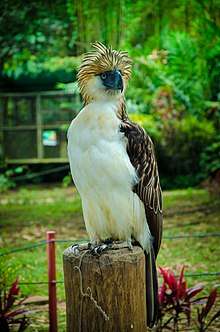
Movable Tangible Heritage
The Philippines possesses numerous significant movable tangible heritage, both in cultural and natural terms. Many of which have been declared as national treasures and are highly protected by the law. The country has four documentary heritage inscribed in the UNESCO Memory of the World Register, namely, the José Maceda Collection, Philippine Paleographs (Hanunoo, Buhid, Tagbanua, and Pala’wan), Presidential Papers of Manuel L. Quezon, and Radio Broadcast of the Philippine People Power Revolution. Many of the cultural objects of the country are housed in government and private museums and libraries throughout the archipelago, such as the National Museum of the Philippines and the National Library of the Philippines. The country also has 5 mammal species, 4 reptiles, and 10 bird species (1 is migratory) listed by the Zoological Society of London as EDGE (Evolutionarily Distinct and Globally Endangered) species since 2018. Majority of coral species and shark species listed in the Top 100 EDGE Corals list and Top 50 EDGE Shark list, respectively, can be found in the Philippines, which is the biodiversity center of the Coral Triangle. Species included in an EDGE lists are considered by the world's scientific community as species that need the greatest attention both in conservation and in research. Aside from movable heritage under Philippine possession, there are also Philippine-originated artifacts and art pieces that have been looted or bought by foreigners and are now housed by other countries. Such pieces include the Golden Tara, the two existing copies of Doctrina Cristiana, the Boxer Codex, and many others. The following are select Philippine movable tangible heritage figures, both in cultural and natural terms, currently found within the Philippines.[10][23]
| Type | Figures |
|---|---|
| Cultural | Jose Maceda Collection, UNESCO Documentary Heritage • Las Piñas Bamboo Organ • University of Santo Tomas Baybayin Documents • Philippine Paleographs (Hanunoo, Buhid, Tagbanua, and Pala’wan), UNESCO Documentary Heritage • Laguna Copperplate Inscription • Balangay • Spoliarium • Manunggul Jar • Tabon Skull Cap • Callao Bones • Presidential Papers of Manuel L. Quezon, UNESCO Documentary Heritage • Maitum Anthropomorphic Pottery • Sultan Kudarat-Maguindanao Anthropomorphic Pottery • Oton Death Mask • Banton Cloth • Masuso Pots • Butuan Ivory Seal • Radio Broadcast of the Philippine People Power Revolution, UNESCO Documentary Heritage • Bolinao Skull • Monreal stone • Prehistoric beads in the Philippines • España y Filipinas • Prehistoric grave goods in the Philippines • La Bulaqueña • Tampuhan (painting) • Shell tools in the Philippines • San Diego (ship) • The Parisian Life (painting) • Philippine jade artifacts • Arnis • Piña • Ikat • Bakya • Balangiga bells |
| Natural | Philippine Eagle, EDGE Bird • Alveopora excelsa, EDGE Coral • Sulu hornbill, EGDE Bird • Dugong, EDGE Mammal • Tamaraw • Philippine Pangolin, EDGE Mammal • Philippine Tarsier • Cloud Rat • Hawksbill turtle, EDGE Reptile • Leatherback turtle, EDGE Reptile • Sulu bleeding-heart, EDGE Bird • Alveopora minuta, EDGE Coral • Mindoro bleeding-heart, EDGE Bird • Narra • Walingwaling • Ylang-ylang • Spoon-billed sandpiper, EDGE Bird • Jade Vine • Ross' wolf snake • Moseleya latistellata, EDGE Coral • Philippine Crocodile • Cebu Small Worm Skink, EDGE Reptile • Cebu flowerpecker, EDGE Bird • Montastrea salebrosa, EDGE Coral • Northern Sierra Madre forest monitor • Dinagat gymnure, EDGE Mammal • Calamian Deer • Philippine Warty Pig • Visayan leopard cat • Negros bleeding-heart, EDGE Bird • Sardinella tawilis • Whale shark • Turbinaria mesenterina, EDGE Coral • Philippine mouse-deer • Fin whale, EDGE Mammal • Shorea astylosa • Blue whale, EDGE Mammal • Turbinaria peltata, EDGE Coral • Green turtle, EDGE Reptile • Sperm whale, EGDE Mammal • Black-hooded Coucal, EDGE Bird • Cebu brown-dove, EDGE Bird • Walden's hornbill, EDGE Bird • Stylocoeniella cocosensis, EDGE Coral • Lobophyllia serratus, EDGE Coral • Largetooth sawfish, EDGE Shark & Ray • Longcomb sawfish, EDGE Shark & Ray |

Intangible Heritage
The Philippines is widely regarded as the traditional capital of the world's festivities due to the thousands of festivals occurring in the country annually. Festivals differentiate in the national level, regional level, provincial level, municipal (town) level, city level, and barangay (village) level. The country, having at least 144 distinct ethno-linguistic groups, has a wide range of intangible cultural heritage, ranging from oral traditions and expressions, performing arts, social practices such as rituals and festive events, knowledge and practices concerning nature and the universe, to traditional craftsmanship. The country currently possesses at least three UNESCO intangible cultural heritage elements, one of which, the Hudhud Epic Chants of the Ifugao, was declared by UNESCO as one of the eleven great traditions of humanity. The other two elements inscribed by UNESCO are the Darangen Chant of the Maranao people of Lake Lanao and the Punnuk tug-of-war Game of the Ifugao. Education concerning Philippine mythology is also a notable intangible heritage of the country. The following elements are select intangible heritage of the Philippines:[11]
| Domain | Intangible Heritage/Element |
|---|---|
| Oral Traditions and Expressions | Hudhud Epic Chant of the Ifugao, UNESCO Intangible Cultural Element • Darangen Epic Chant of the Maranao, UNESCO Intangible Cultural Element • Biag ni Lam-ang Epic of the Ilocano • Salsila of the Tausug • Ulalim Epic of the Kalinga • Dulimaman Epic of the Itneg • Mi’Raj of the Sama Dilaut • Hinilawod Epic of the Sulod • Agyu Epic of the Manobo • Laji of the Ivatan • Kudaman Epic of the Tagbanwa and Palaw'an • Guman Epic of the Subanon • Lumalindaw Epic of the Gaddang • Loa of the Tagalog |
| Performing Arts | Arakyo of the Tagalog • Sagayan of the Maranao • Zarzuela – Musical Theatre of the Tagalog • Singkil Dance of the Maranao • Moro y Cristianos Street Drama of the Tagalog • Pasion of the Tagalog • Moriones Festival of the Tagalog • Kuratsa Dance of the Waray • Kambuyok/Kambuyoka Song Joust of the Maranao |
| Social Practices, Rituals, and Festive Events | Punnuk (Traditional Tugging Ritual) of the Ifugao, UNESCO Intangible Cultural Element • Ilocano Atang for the Dead • Magpandipandi of the Yakan • Hanunoo Mangyan Kinship • Kesiyahan of the T'boli • Bagongonon of the Kalinga • Pasaka of the Hanunoo Mangyan • Ba’i a Labi Coronation of the Maranao • Kapayvanuvanuwa Fishing Ritual of the Ivatan • Pupuwa Ritual of the Tagalog • Gomek Gomanan of the Bagobo • Dawdawak Ritual of the Kankanay • Prayer Rituals of the Kankanay • Adumba Rituals of the Kalinga • Isama Rites of Samal • Kalagan Rites of Passage • Yabyab Rites of the Kalinga • Ati-atihan festival of Aklan • Mo-ninum Ritual of the T'boli • Apung Iru of the Kapampangan • Kuraldal Atlung Ari of the Kapampangan • Peñafrancia Fluvial Festival of the Bicolano • Erwap (Rain Ritual) of the Bontok • Maffusi Ritual of the Ibanag • Sama Mortuary Rituals • Itneg Death and Burial Rituals • Pagbuy’is Ritual of the Tagbanwa • Lekat (Ritual Massage) of Maguindanao • Hamboki’an of the Ikalahan • Pag-gunting Rites of the Tausug • Uyaue (Baiya) Ritual of the Ifugao |
| Knowledge/Practices on Nature and Universe | B’laan Astrology • Hanunoo Mangyan Cosmology • Jama Mapun Constellation of Tanggong • Tagbanwa/Pala’wan Cosmology • Tala’andig Cosmology • Klata Cosmology • Manuvu Cosmology • Matigsalug Cosmology • Tau’t Batu Cosmology • Punhugutan of the Hanunoo Mangyan • Jama Mapun Constellations • B’laan Sacred Trees Knowledge and Practices • Pamitu’on/Pamateun – Astral Lore of the Matigsalug Manobo • Ifugao Deities Knowledge |
| Traditional Craftsmanship | Pis syabit of the Tausug • Maranao Goldsmithing in Tugaya • Sinadumparan Ivatan House Types • Torogan – Royalty House of the Maranao • Salakot of the Tagalog • Yakan Musical Instruments • Bubo and Other Fish Traps of the Ilocano • Sarimanok of the Maranao • Yuvuk of Itbayat • Mountain Terraces craftsmanship of the Ifugao • Piña Loom-weaving of the Aklanon • Tepo Mat (Baluy Mat Weaving) of the Sama • Tikog Mat of the Waray • Saked – Broom-making of the Kalinga • Balaka – Nito Hat of the Kankanay |
.jpg)
In general
As an archipelago composed of 7,641 islands, the Philippines offers a range of attractions such as the white sand beaches of Boracay and Cebu, surfing spots in Siargao, rice terraces of Ifugao, Mayon Volcano in Albay, diving sites of Palawan and Cebu, heritage houses in Vigan, and the cultural /shopping attractions of Cebu, and Metro Manila.
The island of Luzon is considered the political and economic center of the Philippines. The economy of Luzon is centered in Metro Manila, the national capital region. Manila was ranked 11th most attractive city for American shoppers out of 25 Asia Pacific cities by a Global Blue survey in 2012.[24] Shopping malls can be found around the metropolis, especially in the business and financial districts of Makati, Ortigas and Bonifacio Global City. Despite the rise of modern shopping malls, traditional Filipino shopping centers such as flea markets and bazaars still remain around the metropolis.
The Visayas, the central island group of the Philippines, is the heart of the country's biodiversity. The most popular destinations in Visayas are Cebu and Boracay: islands popular for pure white sand beaches and has been favorite island destinations for local and foreign visitors.[25][26] In 2012, Boracay received the "best island" award from the international travel magazine Travel + Leisure.[27][28] Aside from its white sand beaches, Boracay is also a popular destination for relaxation, tranquility and an exciting nightlife.[29] In 2018, 3 Philippine islands, Siargao Island, Boracay, and Palawan, were listed on Condé Nast Traveler's list of Asia's best islands. The three islands were ranked first, second, and third, respectively.[30]
Mindanao, the southernmost island of the Philippines, is known for its mountain ranges; it is one of the best climbing destinations in the Philippines. Mindanao is home to the country's highest mountain, Mount Apo. On average, it takes two days to reach the summit. The mountain has a wide range of flora and fauna, including over 272 bird species, 111 of which are endemic to the area, including the national bird, the Philippine eagle.[31] Mount Apo has become a popular hiking destination for mountain climbers.[32]
Filipino cuisine

Filipino cuisine is the polymerization of 144 distinct cuisines in the Philippines, coming from separate ethno-linguistic groups. The style of cooking and the food associated with it have evolved over many centuries from their Austronesian origins (shared with Malaysian and Indonesian cuisines) to a mixed cuisine of Indian, Chinese, Spanish, and American influences, in line with the major waves of influence that had enriched the cultures of the archipelago, as well as others adapted to indigenous ingredients and the local palate. Examples of Filipino food include kare-kare, lumpia, pancit, lechon, kaldereta, inasal, dinuguan, pinakbet, sisig, leche flan, halo-halo, pandesal, champorado, kinilaw, tocino, ensaymada, pitsi-pitsi, sapin-sapin, adobo, puto, chicharrón, bibingka, hopia, ube, gulaman, pinangat, satti, rendang, tinola, sambal, mami, lugaw, dinengdeng, atchara, nata de coco, kutsinta, suman, isaw, polvoron, pinikpikan, and balut. Adobo and ube are the most internationally known.[33]
Tourism activities

Beach and diving tourism
Beach tourism is currently the major tourist draw of the Philippines. Various beaches in the Philippines have landed in multiple magazines, ranking them anywhere between 1st place to 8th place. Among the most popular beach and diving choices in the country includes Boracay, El Nido, Coron, Cebu, and Siargao. Other common beach places are in Samal, Cagayan, La Union, Pangasinan, Zambales, Batangas, Iloilo, Dumaguete, Camarines Sur and Zamboanga. In 2018, Canadian-based travel agency Flight Network listed Hidden Beach in Palawan (No. 1) as the best beach in all of Asia. The beach was also cited by Travel+Leisure as among the 13 places to see the bluest water in the world. Other beaches ranked from the Philippines were Guyam White Sand Beach in Siargao (No. 13), Palaui Beach in Cagayan Valley (No. 22), Caramoan Island Beach in Camarines Sur (No. 29), Dahican Beach in Mati, Davao Oriental (No. 41), Gumasa Beach in Sarangani (No. 45), Alona Beach in Panglao, Bohol (No. 46), Kalanggaman Island in Cebu (No. 49), and Paliton Beach in Siquijor (No. 50).[34]
Hiking tourism
Hiking is a rising form of tourism in the Philippines, especially among locals and Western foreigners. Among the most famous hiking areas in the country are Mount Apo, Mount Pinatubo, Mount Halcon, Mount Banahaw, Mount Makiling, and Mount Pulag.
Online magazine, Culture Trip, cited Mount Batulao in Batangas, Masungi Georeserve in Rizal, Tarak Ridge in Bataan, Mount Daraitan and Maynoba in Rizal, Kibungan Circuit in Benguet, and Mount Pulag in Nueva Vizcaya for having the most spectacular hiking trails in the country in 2017.[35]
Research and education tourism
Due to the diverse number of flora and fauna of the country, researchers from around the world have flocked various biodiversity sites in Philippine environmental corridors. Among the big draws for environmental researchers include Mount Mantalingajan, Sibuyan Island, Dinagat Islands, Mount Hamiguitan, Central Panay Mountain Range, Verde Island Passage, Tubbataha Reef, Mount Malindang, Northern Sierra Madre Natural Park, and Turtle Islands, Tawi-Tawi. Local and foreign archaeologists and anthropologists have also flocked the country's archaeological sites, such as Cagayan Valley, Butuan, Tabon Cave, Callao Cave, Banton, Ifugao, Cebu, Lanao del Sur, and many others. Various universities in the country, such as University of the Philippines, Ateneo de Manila University, De La Salle University, University of Santo Tomas, Silliman University, University of San Carlos, and University of Mindanao, have also been influential in research tourism, especially for graduate students and students seeking better review centers. Common nationals that seek graduate degrees or reviewer sessions in the Philippines usually come from India, South Korea, and Palau. Language schools with English language programs are also popular among Asian foreigners from South Korea, Thailand, Vietnam, Myanmar, Taiwan, and Japan. Government-approved institutions that teach Philippine mythology and suyat scripts, such as baybayin, have also become popular among locals and foreigners.
Arts and crafts tourism
Arts and crafts tourism in the Philippines has recently expanded following several attempts to establish a cultural renaissance. The numbers of art museums, galleries, exhibitions, festivals, and town fairs throughout the country has doubled in the past 10 years. The country was conferred its first UNESCO Creative City through Baguio in 2016. Other arts and crafts centers are in Manila, Quezon City, San Fernando City, Iloilo City, Angono, Santiago City, Cebu City, Basey, Davao City, Lake Sebu, Angeles, Vigan, Basco, Zamboanga City, Marawi, Tugaya, Cotabato City, Sariaya, Tagbilaran, and Dumaguete.
Pilgrimage tourism
The Philippines is the Catholic pilgrimage capital of Asia, possessing hundreds of olden churches, most of which were established between the 15th to 19th centuries through the earthquake baroque architecture. Historic mosques, temples, and indigenous places of worship such as dambanas are also present throughout the country. Among the most popular pilgrimage sites in the Philippines are Paoay Church, Manila Cathedral, Maragondon Church, Cebu Metropolitan Cathedral, Baclayon Church, Panay Church, Loboc Church, Daraga Church, Boljoon Church, Guiuan Church, Calasiao Church, Manaoag Church, Tumauini Church, Naga Cathedral, San Sebastian Church of Bacolod, Betis Church, Quiapo Church, Taal Basilica, Miagao Church, Caraga Church, Paete Church, Lucban Church, San Sebastian Church of Manila, Jimenez Church, Barasoain Church, Seng Guan Temple, Sheik Karimol Makhdum Mosque, Taluksangay Mosque, Sultan Haji Hassanal Bolkiah Masjid, Masjid Dimaukom, Mount Banahaw, Kabayan Mummy Burial Caves, Limestone tombs of Kamhantik, Bud Bongao, Mount Apo, Mount Bulusan, Mount Pulag, Callao Cave, Mount Kalatungan, Mount Matutum, Mount Makiling, Kanlaon, Mount Arayat, Mayon Volcano, Mount Pinatubo, and Mount Kitanglad.
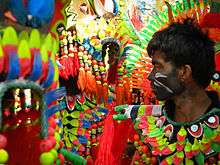
Fiesta tourism
Various festivals in the country are flocked annually by both locals and foreigners. The country has been known as the traditional capital of the world's festivities and the capital of fun due to the thousands of festivals which happen in the country, most of which are annual spectacles. Among the most famous of these events are the Sinulog Festival of Cebu, the Kadayawan Festival of Davao, the Ati-Atihan Festival of Aklan, the Dinagyang Festival of Iloilo, the Panagbenga Festival of Baguio, the Moriones Festival of Marinduque, the Pahiyas Festival of Quezon province, the Obando Fertility Rites Festival of Bulacan, the Pintados Festival of Leyte, the Sandugo Festival of Bohol, the Ibalong Festival of Bicol, the MassKara Festival of Bacolod, and the Giant Lantern Festival of Pampanga. Each of the festivals, or locally known as fiesta, have different traditions at play. The festivals may be Anitist, Hindu, Buddhist, Catholic, Muslim, or a mixture of religions in origin. Some festivals, however, are not interlaced with any form of religion.

Wellness tourism
Wellness tourism has recently doubled its contribution to Philippine tourism due to the rise of hilot (ancient Filipino art of healing) practices in spas, bath houses, and hotels. Surges in patriotism for whole-body firewood pot bathing and indigenous herbal usage have also helped the industry to prosper in the village-level. Staycation, or staying in hotels for relaxation purposes, has also become a trend, along with the increase of yoga, as rooted to the Indian roots of many indigenous Filipino cultures. Hilot havens include Camiguin, Siquijor, and Antique, while staycation destinations include the hotels of Manila, Bataan, Batanes, Tagaytay, Baguio, and Bukidnon.
Heritage towns and cities
The Philippines is home to numerous heritage towns and cities, many of which have been intentionally destroyed by the Japanese through fire tactics in World War II and the Americans through bombings during the same war. After the war, the government of the Empire of Japan withheld from giving funds to the Philippines for the restoration of the heritage towns they destroyed, effectively destroying any chances of restoration since the pre-war Philippines' economy was devastated and had limited monetary supply. On the other hand, the United States gave minimal funding for only two of the hundreds of cities they destroyed, namely, Manila and Baguio. Today, only the centres (poblacion or downtown areas) of Filipino heritage towns and cities remain in most of the expansive heritage cities and towns in the country. Yet, some heritage cities in their former glory prior to the war still exist, such as the UNESCO city of Vigan which was the only heritage town saved from American bombing and Japanese fire and kamikaze tactics. The country currently lacks a city/town-singular architectural style law. Due to this, unaesthetic cement or shanty structures have taken over heritage buildings annually, destroying many former heritage townscapes. Some heritage buildings have been demolished or sold to corporations, and have been replaced by commercial structures such as shopping centers, condominium units, or newly-furnished modern-style buildings, completely destroying the old aesthetics of many former heritage towns and cities. This is one of the reasons why UNESCO has repeatedly withheld from inscribing further Filipino heritage towns in the World Heritage List since 1999. Only the heritage city of Vigan has a town law that guarantees its singular architecture (the Vigan colonial style) shall always be used in constructions and reconstructions. While Silay, Iloilo City, and San Fernando de Pampanga have ordinances giving certain tax exemptions to owners of heritage houses.[36] In 2010, the Philippine Cultural Heritage Act passed into law, effectively giving protection to all cultural heritage properties of the Philippines. However, despite its passage, many ancestral home owners continue to approve the demolition of ancestral structures. In certain cases, government entities themselves were the purveyors of such demolitions.[37] Because of the minimal reach of the current governmental culture agency and the lack of awareness on the importance of Filipino sites, a bill establishing a Department of Culture was formally filed in 2016. The bill is expected to pass into law by late 2018 or early 2019 as it was declared a priority legislation by both houses of Congress. If the bill reaches its deadline, a secretary of culture will be appointed by June–July 2019.[38]
In Luzon, other notable heritage towns and cities include the UNESCO City of Manila, Taal, UNESCO Town of Banaue, UNESCO Town of Mayoyao, UNESOC Town of Hungduan, UNESCO Town of Kiangan, Laoag, Sarrat, Pila, UNESCO City of Baguio, San Fernando, Bacolor, Guagua, Santa Rita, Malolos, Angeles, Sabtang, Mahatao, Uyugan, Sariaya, San Pablo, Alaminos de Laguna, Tayabas, Lucban, Lucena, Balayan, Calaca, Kawit, UNESCO Town of Paoay, Batac, Roxas, Panay, Daraga, Legazpi, Camalig, Antipolo, Angono, Tanay, Morong de Rizal, Baras, Majayjay, Nagcarlan, Liliw, Magdalena, Pagsanjan, Paete, Pakil, Quezon City, Naga, Maragondon, Lingayen, Alaminos, San Miguel, Bustos, Plaridel, Angat, Baliuag, Los Baños, Calamba, Corregidor, San Juan de Batangas, Cabuyao, Biñan, Santa Rosa, Tuguegarao, Malabon, Sagada, Baler, San Juan de Manila, Daet, Tabaco, Batangas City, San Nicolas, UNESCO Town of Santa Maria, and Santa Cruz.[39]
In the Visayas, notable heritage towns and cities include Iloilo City, UNESCO Town of Miagao, Cebu City, Silay, Carcar, Argao, Dalaguete, Oslob, UNESCO City of Puerto Princesa, Bacolod, Dumaguete, Bacong, Romblon, Boac, Baclayon, Tagbilaran, Dauis, Panglao, Victorias, Capul, Cuyo, Taytay, Culion, Lazi, and Bantayan.[39]
In Mindanao, notable heritage towns and cities include Dapitan, Lake Sebu, Zamboanga City, Jimenez, Ozamiz, Oroquieta, Cagayan de Oro, Jasaan, Balingasag, Butuan, Cabadbaran, Iligan, Marawi, Jolo, Davao City, UNESCO Town of Tugaya, UNESCO Town of Mati, and Glan.[39]
Visa policy
The visa policy of the Philippines is governed by Commonwealth Act No. 613, also known as the Philippine Immigration Act, and by subsequent legislation amending it. The Act is jointly enforced by the Department of Foreign Affairs (DFA) and the Bureau of Immigration (BI).
Generally, foreign nationals who wish to enter the Philippines require a visa unless:
- He/she is a citizen of a member state of the Association of Southeast Asian Nations (ASEAN)
- He/she is a citizen of a non-ASEAN member state whose nationals are allowed to enter the Philippines visa-free
- He/she is a balikbayan and is only returning to the Philippines temporarily
Most foreign nationals are visa-free for 14 days, 30 day, or 59 days. Of more than 200 countries and territories, 39 need visas to enter the Philippines.[40][41]
Immigration and customs
Guidelines on the entry of temporary visitors to the Philippines
Nationals from countries who are travelling to the Philippines for business and tourism purposes are allowed to enter the Philippines obtaining visa on arrival for a stay not exceeding 30 days, provided they hold valid tickets for their return journey to port of origin or next port of destination. However, immigration officers at ports of entry may exercise their discretion to admit holders of passports valid for at least sixty days beyond the intended period of stay.[42]
Customs
Upon arriving, visitors are allowed to bring in duty-free personal belongings, two cartons of cigarettes or two tins of pipe tobacco and up to one liter of alcohol. Exceeding this is illegal. Balikbayans have separate rules and should check with the embassy or consulate in their home city.[42]
Currency
The main currency in the Philippines is the peso (piso) (PHP) and its subunit is the centavo (sentimo). 100 centavos is equal to 1 peso. Coins in circulation are: 1, 5, 10, and 25 centavos, P1, P5 and P10. Banknotes in circulation are: 20, 50, 100, 200, 500 and 1,000 pesos.[42]
Foreign currency may be exchanged at the hotel, and in most of the large department stores, banks and authorized money changing shops. Exchanging money anywhere else is illegal and the laws are strictly enforced.[42]
Most large stores, restaurants, hotels and resorts accept major credit cards including American Express, Visas and MasterCard. Traveller's checks preferably American Express are accepted at hotels and large department stores. Personal checks drawn on foreign banks are generally not accepted.[42]
Currency regulations
It is illegal for any incoming or outgoing passenger to bring in or out Philippine pesos in excess of P10,000.00 without prior authority from the Bangko Sentral ng Pilipinas. Any violation of this rule may lead to its seizure and civil penalties and / or criminal prosecution.[42]
The transportation of foreign currency or monetary instruments is legal. However, the carrying of foreign currency in excess of US$10,000.00 or its equivalent in other foreign currencies must be declared to a Customs Officer or the Bangko Sentral ng Pilipinas. Violation of this rule may lead to seizure and sanctions, fines and / or penalties.[42]
Transportation

Air transportation
Currently, there are eleven airports classified by the Civil Aviation Authority of the Philippines as International Airports. There are also hundreds of principal domestic airports and community airports throughout the country. Aside from the eleven international airports, there are also two international airports that are currently being constructed in Albay and Bohol. The eleven international airports include:
- Clark International Airport in Mabalacat, Pampanga
- Mactan–Cebu International Airport in Lapu-Lapu City, Cebu
- Francisco Bangoy International Airport in Davao City
- General Santos International Airport in General Santos City
- Iloilo International Airport in Cabatuan, Iloilo
- Kalibo International Airport in Kalibo, Aklan
- Laoag International Airport in Laoag, Ilocos Norte
- Ninoy Aquino International Airport in Pasay / Parañaque
- Puerto Princesa International Airport in Puerto Princesa
- Subic Bay International Airport in Morong, Bataan
- Zamboanga International Airport in Zamboanga City
Sea transportation
The country traditionally used sea vehicles since pre-colonial times. The archipelagic country has four areas of ports concentration, as administered by the Philippine Ports Authority. These areas are the West Philippine Sea ports area, Philippine Sea ports area, Celebes Sea ports area, and Inland Seas ports area. Each area has hundreds of ports serving local and international ships and other sea vehicles.[43]
Land transportation
Land transportation in the Philippines is administered through various means such as trains, jeepneys, tricycles, taxis, buses, and many others. Various Philippine expressway network have been established throughout the country to hasten land transportation. Construction of more expressway networks and train railways are currently being made by the government, especially for Mindanao. Rail transport in the Philippines is mostly administered by the Philippine National Railways, while the Philippine expressway network and the Philippine highway network are mostly administered by the Department of Public Works and Highways.
International Tourism Offices
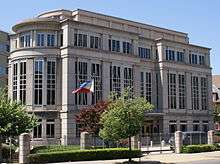
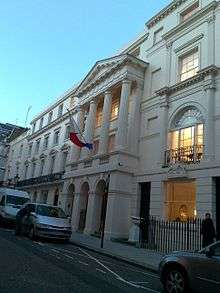
Every town and city in the Philippines has at least one tourism office. The country has also established numerous tourism offices in various foreign countries. The international tourism offices include:[44]
- Tokyo, Japan
- Osaka, Japan
- Seoul, South Korea
- Petaling Jaya, Malaysia
- Singapore
- Taipei, Taiwan
- Bangkok, Thailand
- Ho Chi Minh, Vietnam
- Jakarta, Indonesia
- New Delhi, India
- Mumbai, India
- Beijing, China
- Shanghai, China
- Sydney, Australia
- London, United Kingdom
- Frankfurt, Germany
- Moscow, Russia
- Madrid, Spain
- Milan, Italy
- Paris, France
- Dubai, UAE
- Toronto, Canada
- New York, USA
- San Francisco, USA
- Los Angeles, USA
Aside from the international tourism offices, embassies and consulates of the Philippines throughout the world also serve as de facto international tourism offices.
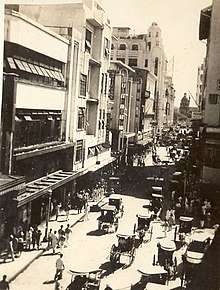
Threats
Terrorism may pose the greatest threat to tourists' safety in the Philippines, notably in the southern regions bordering Malaysia. While most parts of the Philippines archipelago are relatively safe to visit, certain areas where terrorist cells have been at large are best avoided. The far-southern region is widely known as a no-go zone for foreign visitors. Areas surrounding Marawi and other parts of the island are considered unsafe. This is because rebel groups like the Maute Group and Moro Islamic Liberation Front (MILF) are active in these areas and have been held responsible for a number of violent incidents. However, since not all parts of Mindanao have terrorist cells and rebel areas, Mindanao is still a relatively safe place to visit and as long as one is aware of their surroundings and one has knowledge of the places to visit and have knowledge that these places should be avoided, then one can enjoy travel as much as other tourist destinations.[45]
Certain militant Islamist groups such as Abu Sayyaf and Jema'ah Islamiyah are particularly dangerous, since they are responsible for the majority of recent attacks, which have included bombings, piracies, kidnappings and killings of foreign nationals if their government failed to pay the demanded ransom.[46] The New People's Army of the Communist Party of the Philippines has from time to time been listed as a rebel or terrorist group by the Philippines and the United States.[47]
Other threats are mostly focused on heritage destruction. There include cultural heritage destruction such as the demolitions of many heritage structures annually with little opposition from the government, government infrastructure projects (such as road projects) that destroy or damage heritage structures and archaeological sites, looting of heritage sites (usually by foreigners or locals paid by foreigners), illegal treasure hunting activities by foreigners and locals, limited funding for heritage restoration, a shift in mall culture, expansive establishment of structures (such as high-rise condominiums and casinos) in heritage zones, irresponsible and destructive heritage restoration activities from government and private entities, and urbanization of younger generations away from indigenous traditions, causing various rituals and practices to fade away due to the absence of a future bearer. Natural heritage destruction is also a huge problem due to mining, severe population growth, urbanization, introduction of invasive species, deforestation, irresponsibly establishing structures in forests (such as the proposed Sibuyan Island road project), irresponsibly enlarging structures and roads that lead to the chopping and destruction of centuries-old trees at road sides, illegal fishing, illegal hunting (usually by Chinese and Vietnamese foreigners), illegal wildlife trade, water pollution, air pollution, establishment of coal power plants (such as the proposed coal plant in Sariaya, a heritage town in Quezon), climate change, irresponsible tourists, and a lack of initiative in proper waste disposal among poor brackets in society.[48][49][50][51]
See also
- Visa policy of the Philippines
- Philippine Registry of Cultural Property
- List of festivals in the Philippines
- Arts of the Philippines
- Landmarks of the Philippines
- Culture of the Philippines
- Cuisine of the Philippines
- List of beaches in the Philippines
- Pilipinas Kay Ganda
- Built and Natural Dambanas
- Suyat Scripts of the Philippines
- Architecture of the Philippines
- List of protected areas of the Philippines
- List of Ramsar sites in the Philippines
- Biosphere reserves of the Philippines
- Spanish Colonial Fortifications of the Philippines
- Intangible Cultural Heritage of the Philippines
- Lists of Cultural Properties of the Philippines
- Archaeology of the Philippines
- National Commission for Culture and the Arts
- List of national parks of the Philippines
- World Heritage Sites in the Philippines
- List of mosques in the Philippines
- Ship burial in Asia
- National Artist of the Philippines
- National Living Treasures Award (Philippines)
References
- "Paradise found (again): Travellers vote Palawan archipelago in Philippines 'Best Island in the World' for the second time". Daily Mail UK. September 2, 2016.
- UNESCO World Heritage Centre (October 1, 2012). "UNESCO World Heritage Centre – Rock Islands Southern Lagoon and Tubbataha World Heritage sites win Future Policy Award for marine resource management". Whc.unesco.org. Retrieved March 29, 2018.
- "Tourism: Next engine of growth". Manila Bulletin. Retrieved May 19, 2016.
- "Natural Resources and Environment in Philippines". (n.d.). eTravel Pilipinas. Retrieved January 22, 2009.
- "Daang Matuwid – Achievements". Official Gazette of the Republic of Philippines. Retrieved May 27, 2016.
- "Tourism Dept. claims 2011 a banner year for the Philippines". GMA News Online.
- "It's More Fun in the Philippines official website". Archived from the original on January 1, 2013.
- "Philippines". Travel and Tourism Competitiveness Report. 2017. Retrieved July 4, 2018.
- Calderon, Justin (March 5, 2013). "Philippine tourism to create 3.6m jobs". Inside Investor. Retrieved May 23, 2013.
- "The Philippine Registry of Cultural Property (PRECUP)". Ncca.gov.ph. May 24, 2016. Retrieved March 29, 2018.
- "e-Knowledge Center". ICHCAP. Retrieved March 29, 2018.
- "National Integrated Protected Areas System (NIPAS)". Chm.ph. December 24, 2008. Retrieved March 29, 2018.
- "Protected Areas". Denr.gov.ph. September 7, 2017. Retrieved March 29, 2018.
- "INDUSTRY PERFORMANCE FOR TRAVEL AND TOURISM". September 10, 2015.
- Afp (March 22, 2017). "Philippines complains drug war reports hurting tourism | Daily Mail Online". Dailymail.co.uk. Retrieved March 29, 2018.
- "Department of Tourism-Philippines". www.tourism.gov.ph. Philippine Department of Tourism. Retrieved February 19, 2020.
- "Visitor Arrivals to the Philippines by Country of Residence January–December 2018" (PDF). Philippine Department of Tourism. Retrieved January 8, 2020.
- "Visitor Arrivals to the Philippines by Country of Residence January–December 2017" (PDF). Philippine Department of Tourism. Retrieved January 8, 2020.
- "Visitor Arrivals to the Philippines by Country of Residence January–December 2016" (PDF). Philippine Department of Tourism. Retrieved January 8, 2020.
- "Visitor Arrivals to the Philippines by Country of Residence January–December 2015" (PDF). Philippine Department of Tourism. Retrieved January 8, 2020.
- "Visitor Arrivals to the Philippines by Country of Residence January–December 2014" (PDF). Philippine Department of Tourism. Retrieved January 8, 2020.
- "Why Hotspots Matter – Conservation International". Conservation.org. November 20, 2015. Retrieved March 29, 2018.
- "Species". EDGE of Existence. June 3, 2017. Retrieved March 29, 2018.
- "Manila 11th most attractive shopping destination in Asia Pacific –study". Yahoo! Philippines. Retrieved March 26, 2013.
- "Philippines' Boracay attracted 1.36 million tourists in 2013". Xinhua. Retrieved February 22, 2014.
- "Boracay attracted record 1.36 million despite 'Yolanda'". PhilSatr. Archived from the original on February 6, 2014. Retrieved February 22, 2014.
- "BORACAY named 2012 No.1 World's Best Island". Boracay Beach Live. Retrieved February 21, 2013.
- "Boracay named world's 2nd best beach". ABS-CBN News. Retrieved March 30, 2013.
- "Relaxation, nightlife both more fun in Boracay". Yahoo! Philippines. Retrieved February 21, 2013.
- Arnaldo, Ma Stella F. (October 12, 2018). "3 Philippine islands on Condé Nast Traveler's list of Asia's best – Ma. Stella F. Arnaldo".
- "Profile – Mt. Apo Natural Park" Archived August 24, 2011, at the Wayback Machine. Philippine Protected Areas and Wildlife Bureau. Retrieved on April 25, 2014.
- "Climbing to the top of the Philippines". BBC Travel. Retrieved April 25, 2014.
- Alejandro, Reynaldo (1985). The Philippine cookbook. New York, New York: Penguin. pp. 12–14. ISBN 978-0-399-51144-8. Retrieved June 30, 2011.
Civitello, Linda (2011). Cuisine and Culture: A History of cavalo and People. John Wiley and Sons. p. 263. ISBN 978-1-118-09875-2. Retrieved June 30, 2011.Just as Filipino people are part Malay, Chinese and Spanish, so is the cuisine of their seven-thousand-island nation
Philippines Country Study Guide. Int'l Business Publications. 2007. p. 111. ISBN 978-1-4330-3970-6. Retrieved June 30, 2011.Throughout the centuries, the islands have incorporated the cuisine of the early Malay settlers, Arab and Chinese traders, and Spanish and American colonizers along with other Oriental and Occidental accent and flavors.
"Philippine Cuisine." Balitapinoy.net. Accessed July 2011.
Morgolis, Jason (February 6, 2014). "Why is it so hard to find a good Filipino restaurant?". Public Radio International. Retrieved December 17, 2014.Philippine food has Chinese, Malaysian, Spanish and American influences — all cultures that have shaped the Philippines.
- "8 Philippine beaches among the best in Asia". philstar.com.
- Escalona, Katrina. "The Most Spectacular Hiking Trails in the Philippines". Culture Trip.
- "Silay in Negros passes landmark heritage ordinance | Inquirer Lifestyle". Lifestyle.inquirer.net. November 23, 2015. Retrieved March 29, 2018.
- "Republic Act No. 10066 Heritage Law". Ncca.gov.ph. February 17, 2015. Retrieved March 29, 2018.
- "'Intangible heritage' at 'Department of Culture' isusulong ng NCCA". Rappler.com. Retrieved August 7, 2018.
- Henares, Ivan (July 22, 2014). "Top 50 Philippine heritage cities and towns to see in your lifetime | Ivan About Town". Ivanhenares.com. Retrieved March 29, 2018.
- "Archived copy". Retrieved June 3, 2018.
- "Archived copy". Archived from the original on March 15, 2014. Retrieved March 15, 2014.CS1 maint: archived copy as title (link)
- "Guidelines on the entry of temporary visitors to the Philippines". Philippine Department of Tourism. Retrieved June 4, 2018.

- "West Philippine Sea Limited To Exclusive Economic Zone". Ph.news.yahoo.com. Retrieved August 7, 2018.
- "Archived copy". Archived from the original on August 8, 2018. Retrieved June 3, 2018.CS1 maint: archived copy as title (link)
- "Terrorism in the Philippines: Places you should avoid". World Nomads.
- Philip Sherwell (May 23, 2016). "How Abu Sayyaf makes a business of beheadings as Islamist terror gang releases 'final message' hostage video". The Telegraph.
- "Duterte declares CPP-NPA as terror group | ABS-CBN News". News.abs-cbn.com. December 5, 2017. Retrieved March 29, 2018.
- Marquez, Buen. "A soaring eyesore: Torre de Manila's construction threatens Rizal Park's skyline – The Palladium Online". Thepalladium.ph. Retrieved March 29, 2018.
- "Oslob loses heritage house – Cebu Daily News | Cebu Daily News". Cebudailynews.inquirer.net. August 14, 2017. Retrieved March 29, 2018.
- "9 Philippine Icons and Traditions That May Disappear Soon". Filipiknow.net. November 4, 2016. Retrieved August 7, 2018.
- Indy N ·. "10 Filipino Traditions We Hardly Perform Anymore – Pinoy Top Tens". Topten.ph. Retrieved March 29, 2018.CS1 maint: extra punctuation (link)
Sources
Andrei Salokhin and Nastia Khanenia. A Traveler’s Guide to the Philippines 2019 [Infographic] Travelblogstories.com Retrieved 2019-05-27
External links
| Wikivoyage has a travel guide for Philippines. |
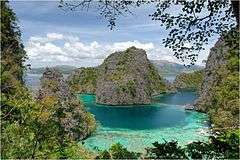

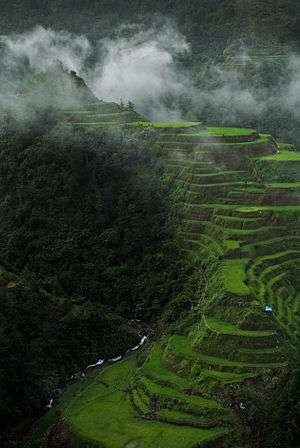

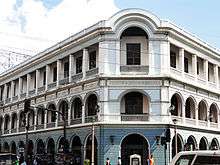

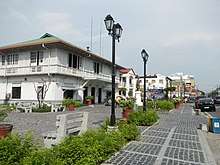
.svg.png)
